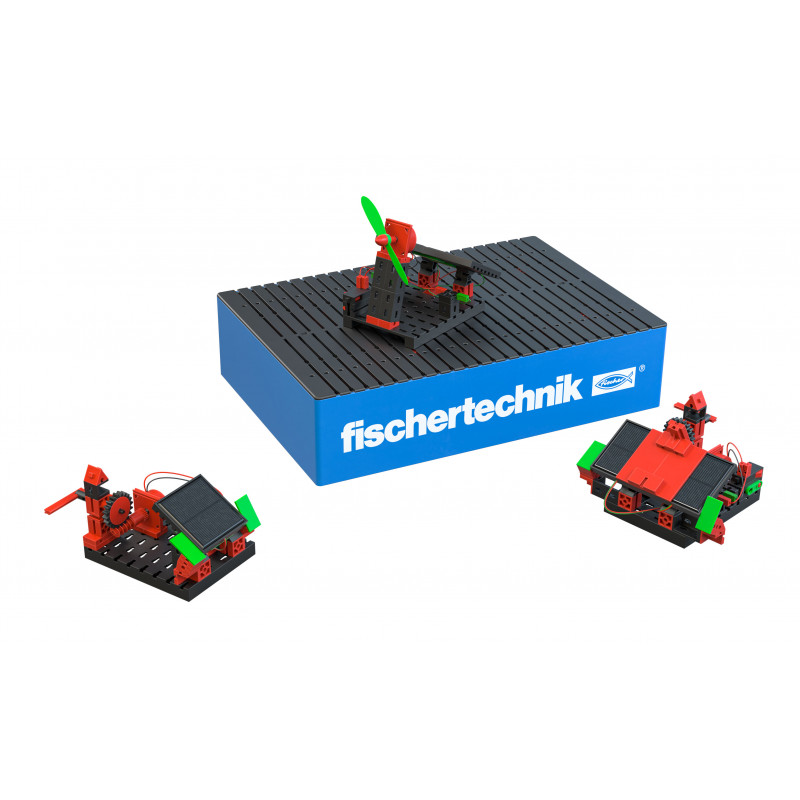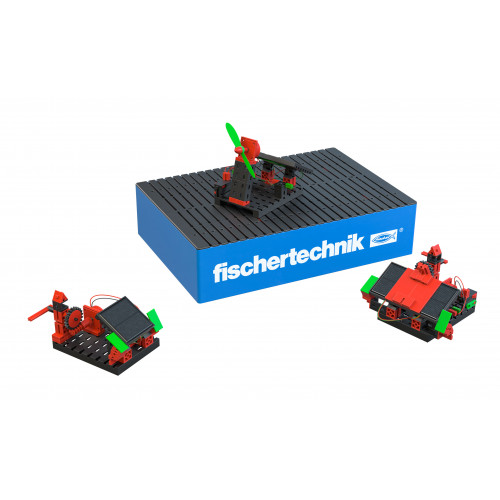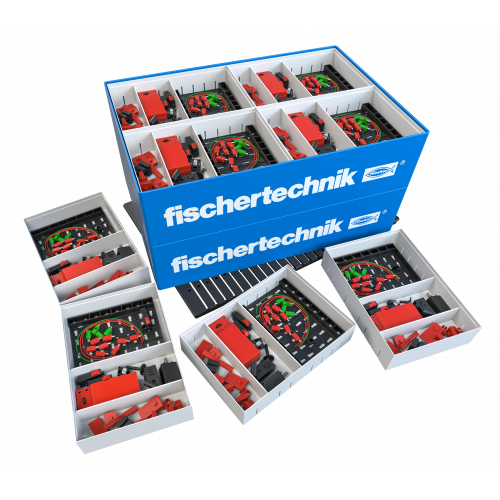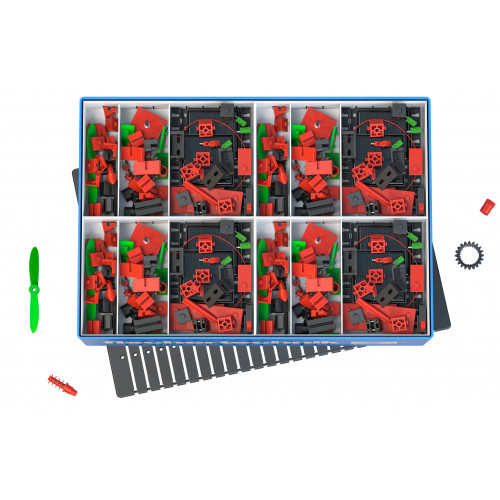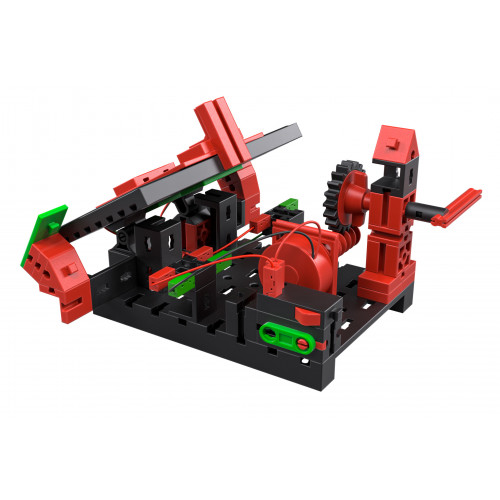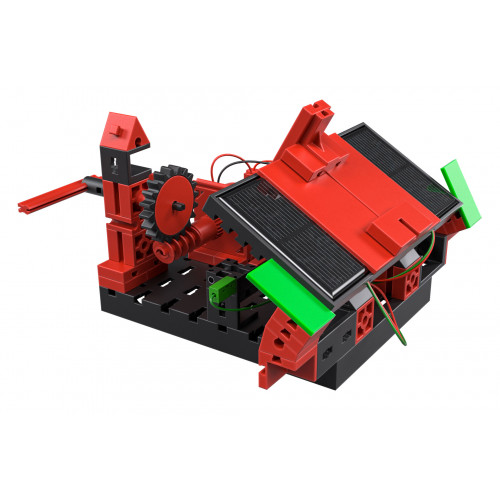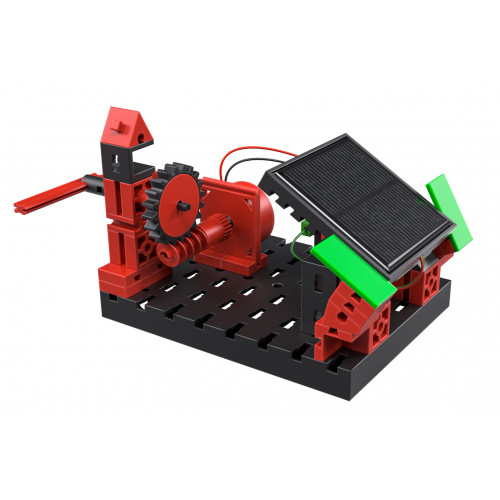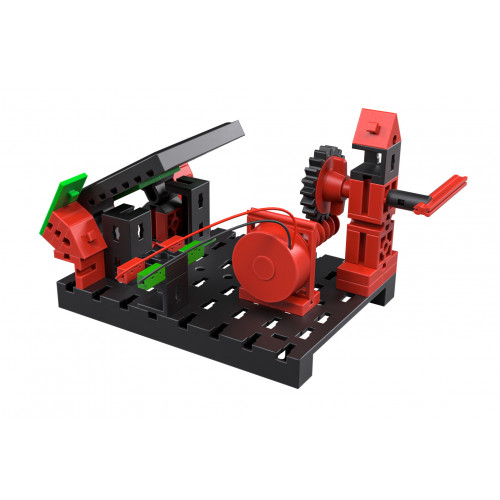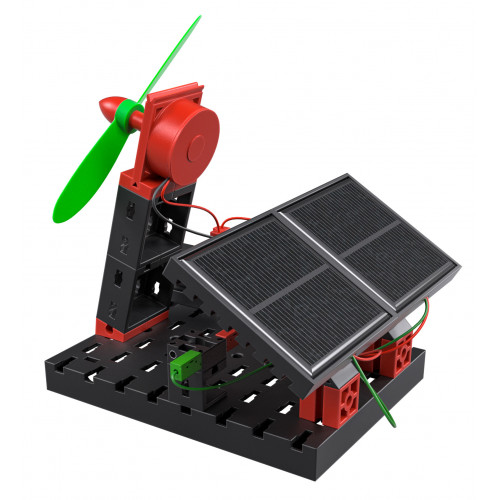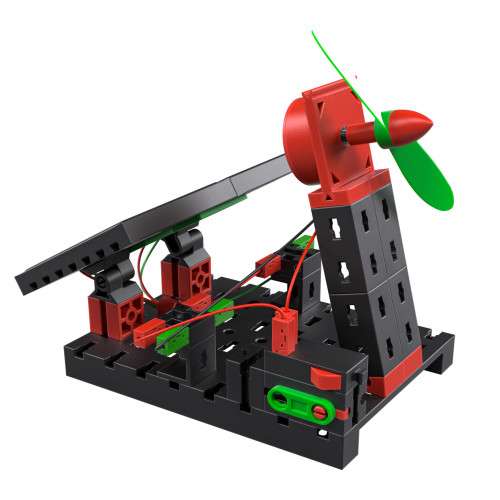CLASS SET Solar Energy
Are you a school or company and do you want to order on account? Please contact us.
Top Facts:
One class set contains 16 individual sets
One class set is suitable for, for example, 30 pupils and one teacher
Communicating solar or solar energy and its use
Two solar modules and one solar motor included
Ten experiments for use in the classroom available online
Accompanying teaching material:
fischertechnik Education products include comprehensive, freely accessible teaching materials. These have been developed together with teacher training colleges, teachers and didacticians and are ideally suited to the needs of the classroom. In addition to the topic introduction, lesson plans with task sheets and educational plan references are available.
- The topic introduction provides content that can be optimally used for lesson preparation and integrated into the lessons. Definitions, history, basic knowledge and much more are provided.- The teaching material includes an overview of the learning objectives as well as the time required for the tasks.
- In line with the curriculum-relevant topics, various tasks are included within which different experiments are dealt with.
- The tasks are divided into a construction task, thematic task and experimentation task. In this way, one progresses from building, to learning technical content, to applying the acquired knowledge.Highlights:Energy generation from renewable solar energy Series and parallel connection
Topic Introduction
Renewable energy is generating energy from sustainable sources, such as the sun, wind, water, geothermal energy sources or biomass. This kind of energy is available in almost unlimited quantities. The sun will continue to burn for around 5 billion more years. Solar radiation can be converted into electricity or heat. Wind energy, hydropower and biomass are also solar energy, in a different form.
Stores of fossil fuels, such as coal, crude oil, natural gas, and conventional nuclear fuels, in contrast, continue to decline with consistent use. These fossil fuels are considered non-renewable energy sources. After they are burned in a power plant or heating plant, they are no longer available for use. They do not regenerate; instead, they are used up.
However, the growing global population and human advances in technological development demand an enormous amount of energy, and this demand is growing all the time. In addition, we know that emissions of the greenhouse gas carbon dioxide (CO2) from burning crude oil, natural gas and coal are very high. We also know that these fossil fuels are part of what is triggering global climate change. The greenhouse gas emissions of renewable energy sources, in contrast, are just 1/10 to 1/100 of those from fossil fuels per unit of energy generated.
The conversion of our energy supply from fossil and nuclear fuels to renewable energy is already in full swing; in Germany, this is referred to as the “Energiewende” or the “Energy revolution”. In addition to expanding the use of renewable energy, other central areas of focus - and key challenges - include reducing our energy consumption and improving energy efficiency through technological progress. The energy revolution is already affecting our everyday lives in terms of electric mobility on the streets, when we purchase energy-efficient household appliances, or during energy-based renovations of buildings.
Current, quality-assured data on the development of renewable energy sources in Germany is provided at regular intervals by the German Federal Environment Agency (1).
But what is energy?
We experience the effects of energy in the form of heat from a fire or the force of the wind. We cannot see, hear, taste or smell energy, but we still use it in many different ways. From physics, we know that: Energy is the capability to do work. When a light is switched on or a car is moved forward using gas, we experience the conversion of one form of energy into another form of energy, with the help of energy converters. Energy, therefore, is not a material, but a property of bodies. Electrical current is not energy. It carries energy and delivers it to electrical devices. The electrical current transports energy.
Therefore, from a strictly scientific perspective, the commonly used phrase renewable energy is not correct. Energy can neither be created nor destroyed; therefore, it cannot be renewed. Energy can only be converted from one form into another. The quantity of energy in a closed system, therefore, remains constant. However, the usable portion of the energy will differ depending on its conversion (2). Overall, the total quantity of energy remains the same. What we call energy usage should more accurately be called the depreciation of energy. The usable value of energy is reduced by conversion and transport. When wood is burned, for instance, the chemical energy stored in the wood is converted into thermal energy and light energy. When heat is dissipated into the environment, it is no longer useful. It has been depreciated – or “used”, as we say.
Our energy consumption continues to grow, even as fossil fuel sources of energy dwindle. This makes experimenting with renewable energy all the more exciting, to understand how solar energy, wind energy and hydropower can be used to convert and store energy and improve the efficiency of energy transmission.
History - The story of renewable energies
Hydropower
Hydropower is certainly one of the oldest energy sources ever used. The ancient Mesopotamians were already using water to produce energy 3,500 years ago with the help of water wheels. The journey from water wheel to turbine was a long one. Enlightenment-era engineering resulted in improvements to the water wheel, and ultimately to the construction of new kinds of machines, such as water column systems. In 1824, Claude Burdin invented the first turbine based on this technology. In 1866, Werner von Siemens invented the electrodynamic generator, making it possible to convert hydropower into electric current. The first hydroelectric plant began operations in the English county of Northumberland in 1880. The first German hydropower plant, which was also the first power station to generate alternating current, went online in 1890 in Bad Reichenhall. The world’s first large-scale power station began operating in 1896 at Niagara Falls in the USA.
Wind power
Initial experiments on producing electricity using wind power were conducted in the late 19th century based on windmill technology, alongside the emergency of electricity itself. In the 1950s, engineer J.Juul pioneered the world's first wind power plant to generate alternating current in Vester Egesborg. J. Juul constructed the innovative Gedser wind power plant with an output of 200 kW from 1956-57 for the SEAS electricity company on the coast of Gedser in southern Denmark. Germany's first wind farm was constructed in 1987 on the Growian facility near Marne.
Photovoltaics
Alexandre Edmond Becquerel discovered the photovoltaic effect in 1839, launching the history of photovoltaics. However, it took over a century for this discovery to be used to produce energy. Albert Einstein provided the first explanation of the photoelectric effect in 1904. Edmond Becquerel had already demonstrated the association between light and energy generation, but was not initially able to derive any use from this discovery. In 1954, the physicists Chapin, Fuller and Pearson succeeded in building the world's first silicon solar cell. This launched the use of crystalline solar cells to convert sunlight into electrical energy. The first 108 photovoltaic cells were used in the mission of the US satellite Vanguard in 1958. However, it took another 20 years for them to be installed on terrestrial systems. In 1976, the Australian government decided to equip the outback telecommunications network with solar cells to charge the installed batteries. In the mid-1980s, Swiss engineer Markus Real was able to install small, decentralised systems on the roofs of houses to demonstrate private usage. Afterwards, many different large-scale solar projects were launched, such as Germany's 1,000 roofs program (1990) or the Japanese 70,000 roofs program (1994). In 2010, Germany exceeded the ten gigawatt threshold for the first time, and in 2012 the country reached 25 gigawatt. As of late 2019, over 49 GW are installed in Germany.
Fundamentals
When the German federal government signed off to eliminate all atomic power on 11 June 2001, the energy revolution – the conversion of the energy system to sustainable energy supply, with the help of renewable energy – came to the forefront of social perception, current research and technological development.
The fischertechnik Renewable Energy Learning Set deals with central questions on energy conversion by force transducers, energy transmission and energy storage of renewable energy sources. The different wind power, hydropower and photovoltaic models invite students to experiment and investigate, and involve topics that address current questions in physics and the natural sciences.
The following fischertechnik components are used to work on the topic of renewable energy:
• the fischertechnik solar micromotor is small, but powerful. It is operated with 0.5-2V direct current.
• two solar cells 60x60 1.0V 0.44A deliver the power needed to drive the models, or serve as energy converters for energy storage
• one solar gold cap 10F 2.3V, with stands out for its extremely high capacity
• one hydro cell 0.5V-0.9V 0.5A fuel cell that can be used to convert the chemical energy of a fuel (such as hydrogen) into electrical current
• one voltage converter, which transforms the output voltage of a fuel cell from approx. 0.9V to approx. 2.0V
Of course, all of these are perfect for the fischertechnik system, which not only illustrates basic renewable energy issues but also allows students to operate realistic functional models.
| fischertechnik construction kit information | |
| Number of parts | 73 (x16 Sets) |
| Number of models | 3 |
| Contents fischertechnik CLASS SET Solar Energy | Download |

























